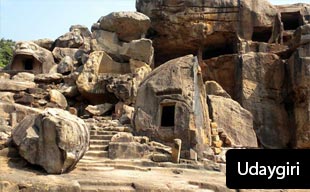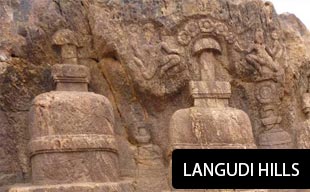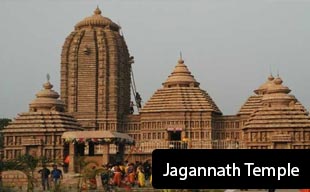DAY-01 :- Morning Arv. BBI. Visit of Kalingan Temples and IInd Century BC. Khandagiri and Udaygiri Jain Caves of Bhubaneswar. ON-BBI.
PARASURAMESWAR :- Considered the best safeguarded example of an early Orissan sanctuary dated to the Sailodbhava period. The sanctuary is accepted to have been worked amid 650 AD in Nagara style. Parsurameswar sanctuary has a vimana, the sanctum, and a bada, the curvilinear tower over its roof top, raising up to a tallness of 40.25 ft (12.27 m). It is the principal sanctuary to have an extra structure called jagamohana, contrasted with the prior sanctuaries that had just the vimana.
MUKTESWAR :- Mukteswar Temple is frequently depicted as one of gems of Odisha (Orissa) for its stunning models and rich looks. The arrangement is currently an undeniable five separated shape, pancharatha and the stage or the pabhaga comprises of five moldings, as in last sanctuaries. The jagamohana of this late ninth century sanctuary is presently a pidha deul with designed roof, cut into a lotus with eight petals. The adjustment in iconography is similarly perceptible with Ketu presented as the ninth planet.
LINGARAJ :- The sanctuary of Lingaraja is exceedingly venerated by the devotees of Hinduism. The term 'Lingaraj'suggests 'the ruler of Lingas', where 'linga' is the phallic type of Lord Shiva. In the eleventh century, Lingaraj Temple was worked by the King Jajati Keshari, who had a place with Soma Vansh. The tall tower of the sanctuary reaches out to the stature of 55 meters and actually, rules the horizon of Bhubaneshwar. The extensive yard includes more than 50 little holy places that are committed to a few Gods of the Hindu pantheon.

KHANDAGIRI and UDAYGIRI CAVES :- One of the soonest gatherings of Jain shake cut safe houses, the hollows of Udayagiri (Hill of Sunrise) and Khandagiri (Broken Hills) summon an interesting position in the field of history, shake cut engineering, workmanship and religion. The two slopes rise suddenly from the beach front plain, around six km west of Bhubaneswar, isolated by an interstate. Rani Gumpha,Hati Gumpha,Chhota Hati Gumpha, Jaya Bijay Gumpha, Manchapuri, Ganesh and Tiger Caves are the most vital and safeguarded Caves in the Udaygiri Hill. So also Nabamuni Gumpha and Barbhuja Caves are the essential collapses the Khandagiri Hill. Each one of those Caves accepted to be built between IInd to Ist Century B.C.
Day-02 :- Drive to Visit Tarapur/Kaima/Langudi Hills, last Buddhist Excavation and Arrive at Ratnagiri. Over Night/Ratnagiri Hotel. The current Excavation of Langudi-Radhanagar-Kaima-Tarapur, accommodates the 'Puspagiri Vihar' of the Chinese Traveller.
TARAPUR :- The current Tarapur unearthing uncovered the distinguishing proof of 'Kesa Stupa' and the gift of 'Bhikhu Tapusa' for building Tarapur Stupa have been comprehended. Two dealers of Utkal Tapassu and Bhallika turned into the main lay supporters of Lord Buddha, according to early Vinayak Texts. Eight modest bunches of his hairs were what Buddha gave them, receiving rice cake and nectar consequently from them. Last on the shippers saved the hairs in a
Stupa (Kesa Stupa) in their local Place.
KAIMA HILLS :- The most intriguing stays of Kaima is a one of a kind shake cut elephant that ascents unexpectedly finished the lower rise on the eastern furthest reaches of the slope, confronting the stream Kimiria. It has been cut out from live shake with brilliant and exceptionally naturalistic craftsmanship. The provisional date of the picture has been relegated to the Mauryan period, around the third century B.C.
RADHANAGAR :- Radhanagar was an antiquated illustrious city. A very much outlined city, Radhanagar held mud defense same as other old urban communities in India including Ujjain, Kosambhi and Sisupalgarh. Ashoka's Dhauli Rock Edict says that Kalinga's regal central station amid Asokan period was 'Tosali'. As indicated by the current Radhanager removal, various engravings and other supportive confirmations mean Radhanagar as the capital city of
'Tosali'. The current exhuming has uncovered the remaining parts of the Radhanagar Fort.

LANGUDI HILLS :- Langudi slope was a conspicuous Buddhist seat of discovering that prospered until the eleventh century in India. This Buddhist archeological site adorned with arrangement of shake cut Buddhist stupas and a few early
medieval Buddhist landmarks and sanctuaries. At Langudi slopes the remnants of a block stupa and an extensive religious community still exist. With everything taken into account, the Buddhist stays on the slope demonstrate that Langudi was a critical focus of the Hinayana,
Mahayana and Vajrayana organizations of Buddhism.
Day-03 :- Visit Ratnagiri/Udaygiri and Lalitgiri Buddhist Monasteries and Stupa. Last drive to Puri. ON-Puri. RATNAGIRI :- A perfect place to have intervention at a young hour in the morning and Evening, on the off chance that somebody want.
The passageway to the primary religious community has some unbelievable cut statues of Vajrapani and Lokeshwara, decorated on its dividers. There are models from Hindu folklore too, which have stood the trial of time with a square-formed inward patio. The amazing 10 ft representation of Lord Buddha, occupied with reflection which is put inside a disengage chamber doubtlessly takes a man to divine awareness. Pay special mind to the impeccably cut entryway board set inside the patio and other astonishing sculptural confirmations, scattered everywhere throughout the complex. The unearthings goes back to sixth Century AD. From Gupta Dynasty, and thought to be of Mahayana organization .
UDAYGIRI :- Udaygiri, the biggest Buddhist complex in Orissa. The historical backdrop of Udayagiri Buddhist complex isn't much known, however what is without a doubt is that it not as old as Ratnagiri or Lalitgiri. Most likely, it existed and
Thrived between the seventh – twelfth AD. Late exhuming have uncovered various Buddhist fortunes. It is currently realized that the antiquated name of the religious community here was Madhavapura Mahavihara. An expansive block religious community together with various Buddhist models have been uncovered. There is additionally another block cloister which is still not uncovered separated from an inscripted ventured stone well and shake cut models.
The remainder of these is situated at the highest point of the slope behind. Bodhisattva figures and Dhyani Buddha figures are different fortunes recouped from this site. Exhuming work is as yet being completed in the Udayagiri Buddhist complex.
LALITGIRI :- Lalitgiri, one of the most punctual Buddhist locales in Orissa, kept up a ceaseless social succession beginning from the post Mauryan period (322– 185 BC) till thirteenth AD. Likewise this site kept up a ceaseless of essence of Buddhism, unbroken, from third BC to 10thAD. Lalitgiri have uncovered leftovers of a substantial stupa on the slope. Inside the stupa, two uncommon stone coffins were found with relics of Buddha; this was the primary such find in Eastern India. The stone coffins, similar to Chinese Puzzle boxes, made of Khondalite stone, uncovered three different boxes inside them, made of steatite, silver and gold individually; the gold coffin, which is the last one, contained a relic or dhatu as a little bit of bone. Also another fascinating find is that of an east-bound aspidal chaityagriha, worked of blocks, 33 by 11 meters in measure with 3.3 meters thick dividers. This building, the main such Buddhist structure found in Odisha, contains a round stupa at its inside. Additionally found were a progression of Kushana Brahmi engravings made on shells with cuts on moonstone at the outskirts of the building.

Day-04:- Visit Holy City Puri and Jagannath Temple. Likewise visit the 'Dark PAGODA', Sun Temple at Konark. ON-Puri.
PURI :- JAGANNATH TEMPLE :- The Shree Jagannath sanctuary at Puri is a standout amongst the most noteworthy landmarks in the state, and is committed to Jagannath, the Lord of the Universe and an incarnation of Vishnu. Developed by King Ananta Varman Chodaganga Deva from Ganga Dynasty in 1198, the sanctuary reveres Lord Jagannath, Subhadra and Balabhadra. The primary sanctuary of Jagannath is a forcing structure encompassed by two dividers. Inside, the 65-meter-high sikhara (tower) is beaten by the banner and wheel of Vishnu and watched by two stone lions and a column delegated by the Garud. Worked in the Kalinga style of engineering, Lord Jagannath is accepted to be the image of Universal peace. Consistently, the gigantically well known custom of Rath Yatra finishes up at the premises, amid which a huge number of enthusiasts throng to the sanctuary. SUN TEMPLE, KONARK :- One of the most shocking landmarks of religious noteworthiness, a genuine perfect work of art of engineering gladly remains as Sun Temple at Konark. Here the dialect of stone thrashings the dialect of human. The Sun Temple of Konark, frequently called as the Black Pagoda, Built in thirteenth century by King Narasimhadeva-II, of the Ganga Dynasty, the sanctuary is composed in the state of an epic chariot with seven
stallions and twelve wheels, conveying the sun God. It is an adequate demonstration of the aesthetic brilliance of the time. Imagined as a tremendous chariot drawn by seven lively steeds on 12 sets of wonderfully beautified wheels- - after the legendary seven stallion chariot of Sun God- - the sanctuary was one of a kind in its engineering and usage.
Day-05:- Visit Chilka Lake for Dolphins and Sea Mouth OR Birds. Last drive to Bhubaneswar. ON-Bhubaneswar. SATAPADA ON CHILKA LAKE :- The pear-formed lake spreads crosswise over 1,100 sq km, and has a one of a kind biological system with a scope of sea-going vegetation found in and around its harsh waters.
DOLPHINS :- Dolphins are the primary fascination of Satapada watercraft ride. Generally some little piece of the tail of the dolphin is obvious. On the off chance that they bounces then just the back of the Dolphin can be seen. The speedboats turn off the motor at the Dolphin focuses to look after quiet.
Fowls :- The Chilka Lake offers the biggest social event of transient feathered creatures in the nation. No big surprise, it was pronounced one of the six wetlands of global significance at the Ramsar Convention on Migratory Species of Arctic and Central Asian Waterfowl. The lake and its islands abound with settling winged creatures like white bellied ocean birds, ospreys, brilliant plover, sand flute players, pelicans, shovellers, gulls, flamingos… and so on., which originate from to the extent Central Asia and Siberia. The Nalabana Island that spreads around 16 sq km was pronounced a flying creature haven. Its center zone (around 9 sq km) draws in around 400,000 water fowls of various species.
Day-06 :- If time Permits visit Hirapur Yogini Temple. DROP AT AIRPORT FOR ONWARD JOURNEY.
*** AS MANY AS DAYS CAN BE ADDED TO THIS PROGRAM.
